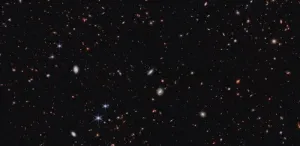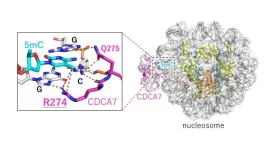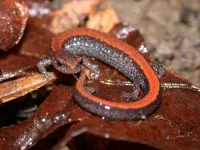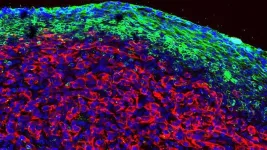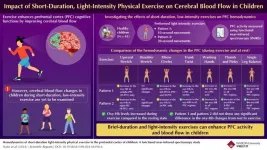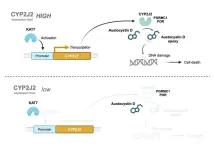(Press-News.org) When astronomers got their first glimpses of galaxies in the early universe from NASA’s James Webb Space Telescope, they were expecting to find galactic pipsqueaks, but instead they found what appeared to be a bevy of Olympic bodybuilders. Some galaxies appeared to have grown so massive, so quickly, that simulations could not account for them. Some researchers suggested this meant that something might be wrong with the theory that explains what the universe is made of and how it has evolved since the big bang, known as the standard model of cosmology.
According to a new study in The Astrophysical Journal led by University of Texas at Austin graduate student Katherine Chworowsky, some of those early galaxies are in fact much less massive than they first appeared. Black holes in some of these galaxies make them appear much brighter and bigger than they really are.
“We are still seeing more galaxies than predicted, although none of them are so massive that they ‘break’ the universe,” Chworowsky said.
The evidence was provided by Webb’s Cosmic Evolution Early Release Science (CEERS) Survey, led by Steven Finkelstein, a professor of astronomy at UT and study co-author.
Black Holes Add to Brightness
According to this latest study, the galaxies that appeared overly massive probably host black holes rapidly consuming gas. Friction in the fast-moving gas emits heat and light, making these galaxies much brighter than they would be if that light emanated just from stars. This extra light can make it appear that the galaxies contain many more stars, and hence are more massive, than we would otherwise estimate. When scientists remove these galaxies, dubbed “little red dots” (based on their red color and small size), from the analysis, the remaining early galaxies are not too massive to fit within predictions of the standard model.
“So, the bottom line is there is no crisis in terms of the standard model of cosmology,” Finkelstein said. “Any time you have a theory that has stood the test of time for so long, you have to have overwhelming evidence to really throw it out. And that’s simply not the case.”
Efficient Star Factories
Although they’ve settled the main problem, a less thorny one remains: There are still about twice as many massive galaxies in Webb’s data of the early universe as expected from the standard model. One possible reason might be that stars formed more quickly in the early universe than they do today.
“Maybe in the early universe, galaxies were better at turning gas into stars,” Chworowsky said.
Star formation happens when hot gas cools enough to succumb to gravity and condense into one or more stars. But as the gas contracts, it heats up, generating outward pressure. In our region of the universe, the balance of these opposing forces tends to make the star formation process very slow. But perhaps, according to some theories, because the early universe was denser than it is today, it was harder to blow gas out during star formation, allowing the process to go faster.
More Evidence of Black Holes
Concurrently, astronomers have been analyzing the spectra of "little red dots" discovered with Webb, with researchers in both the CEERS team and others finding evidence of fast-moving hydrogen gas, a signature of black hole accretion disks. This supports the idea that at least some of the light coming from these compact, red objects comes from gas swirling around black holes rather than stars — reinforcing the conclusion of Chworowsky’s team that the stars are probably not as massive as astronomers initially thought. However, further observations of these intriguing objects are incoming and should help solve the puzzle about how much light comes from stars versus gas around black holes.
Often in science, when you answer one question, that leads to new questions. Although the researchers have shown that the standard model of cosmology probably is not broken, their work points to the need for new ideas in star formation.
“And so, there is still that sense of intrigue,” Chworowsky said. “Not everything is fully understood. That’s what makes doing this kind of science fun, because it’d be a terribly boring field if one paper figured everything out, or there were no more questions to answer.”
Other UT authors are Michael Boylan-Kolchin, Anthony Taylor and Micaela Bagley. They, Finkelstein (as its director) and Chworowsky are members of UT’s Cosmic Frontier Center, which seeks to improve our understanding of the early universe.
Other institutions participating in this research are Colby College, University of Toronto, Texas A&M University, the National Science Foundation’s National Optical-Infrared Astronomy Research Laboratory, NASA Goddard Space Flight Center, University of Connecticut, European Space Astronomy Centre, University of Massachusetts Amherst, University of California at Irvine, Centro de Astrobiología (Spain), The Hebrew University of Jerusalem, Cosmic Dawn Center (Denmark), University of Copenhagen, Flatiron Institute, University of Louisville, Universidad de la Laguna, Université Paris Cité, Swiss Federal Institute of Technology Lausanne, Rochester Institute of Technology, University of Padua (Italy), INAF – Padua Astronomical Observatory (Italy), University of California at Riverside, University of Sussex, University of Malta, University of Groningen, SRON Netherlands Institute for Space Research and National Astronomical Observatory of Japan.
This research was supported by NASA, the Space Telescope Science Institute and the National Science Foundation.
The James Webb Space Telescope is an international program led by NASA with its partners the European Space Agency and the Canadian Space Agency.
END
Early galaxies were not too big for their britches after all
It got called the crisis in cosmology; But now, astronomers can explain some surprising recent discoveries
2024-08-26
ELSE PRESS RELEASES FROM THIS DATE:
SwRI showcases latest warfighter research at military health research symposium
2024-08-26
SAN ANTONIO — August 26, 2024 — Southwest Research Institute will highlight its capacity to advance military medicine and human performance at the Military Health System Research Symposium, August 26-29, in Kissimmee, Florida.
“Southwest Research Institute has a long history of working with several DOD agencies,” said Senior Research Engineer Kreg Zimmern of SwRI’s Chemistry and Chemical Engineering Division. “SwRI offers multidisciplinary expertise, allowing us to manage government contracts ...
Scientific consensus can strengthen pro-climate attitudes in society
2024-08-26
Climate scientists have long agreed that humans are largely responsible for climate change. A new study, co-led by Bojana Većkalov from the University of Amsterdam and Sandra Geiger from the University of Vienna, finds that communicating the scientific consensus about climate change can clear up misperceptions and strengthen beliefs about the existence and the causes of climate change. The team surveyed over 10,000 people from 27 countries on 6 continents. The study has just been published in the renowned journal Nature Human Behaviour.
Scientific consensus identifying humans as primarily responsible ...
Unraveling the role of CDCA7 in maintenance of DNA methylation
2024-08-26
DNA methylation, a process by which methyl groups are added to DNA molecules, is essential for the maintenance of DNA and the overall health of an organism. Disruptions in the standard DNA methylation patterns can lead to immunodeficiency and diseases such as cancer. Helicase lymphoid-specific (HELLS) is an enzyme that facilitates DNA methylation by remodeling the nucleosome - the tightly packed structure of DNA wound around histone proteins. The absence of HELLS or its activator, cell division cycle associated 7 (CDCA7) is known to be a factor that leads to the disruption of DNA methylation. Mutations in the genes that code for HELLS and CDCA7 cause rare disorder immunodeficiency, ...
Study finds salamanders are surprisingly abundant in northeastern forests
2024-08-26
RESTON, Va. — Two recent amphibian-focused studies shed light on the ecological importance of red-backed salamanders, while confirming that proactive measures would prevent costly impacts from a wildlife disease spreading across Europe that has not yet reached North America.
Scientists knew that red-backed salamanders were abundant in eastern North America, but a recent study found their densities and biomass across the region were much higher than expected. The study authors estimated an average of ...
Old chemo drug, new pancreatic cancer therapy?
2024-08-26
The fight against cancer is an arms race, and one of the most effective weapons in clinicians’ arsenals is immunotherapy. Immune checkpoint therapy has become the standard for treating several types of cancer. However, the Nobel Prize-winning strategy is ineffective for most pancreatic ductal adenocarcinoma (PDAC) patients.
“Immune checkpoint therapy is only an option in rare cases of PDAC,” Cold Spring Harbor Laboratory (CSHL) Professor Douglas Fearon says. “It’s only effective for patients with a specific subtype of PDAC—that’s less than 5% of all cases.”
Until recently, it was thought that PDAC didn’t ...
Shakespeare in sign language, seen through AI
2024-08-26
A new study uses co-creation with reference communities to develop an app for sign language machine translation (SLMT). The research team designed a theatrical performance in sign language, seen through the eyes of artificial intelligence (AI), as one of the methodologies. “Historically, deaf people have been excluded from the development of automatic translation technologies,” says Shaun O’Boyle, Research Fellow in the School of Inclusive and Special Education (Dublin City University DCU). “This has often caused backlash and resistance from deaf communities, as the projects were designed and ...
PLOS and the University of South Carolina announce APC-free Open Access publishing agreement
2024-08-26
SAN FRANCISCO — The University of South Carolina and the Public Library of Science (PLOS) today announced a three-year Open Access agreement that allows researchers to publish in PLOS journals[1] without incurring article processing charges (APC). This partnership brings together two organizations that believe researchers should be able to access content freely and make their work available publicly, regardless of their access to funds.
“The evidence is undeniable — open research enables the convergence of ...
Why children can’t pay attention to the task at hand
2024-08-26
COLUMBUS, Ohio – Scientists have learned that children find it hard to focus on a task, and often take in information that won’t help them complete their assignment. But the question is, why?
In a new study, researchers found that this “distributed attention” wasn’t because children’s brains weren’t mature enough to understand the task or pay attention, and it wasn’t because they were easily distracted and lacked the control to focus.
It now appears that kids distribute their attention broadly either out of simple curiosity or because their working memory isn’t developed enough to complete a task without “over ...
Short-duration, light-intensity exercises improve cerebral blood flow in children
2024-08-26
Cognitive functions, also known as intellectual functions, encompass thinking, understanding, memory, language, computation, and judgment, and are performed in the cerebrum. The prefrontal cortex (PFC), located in the frontal lobe of the cerebral cortex, handles these functions. Studies have shown that exercise improves cognitive function through mechanisms such as enhanced cerebral blood flow, structural changes in the brain, and promotion of neurogenesis. However, 81% of children globally do not engage in enough physical activity, leading to high levels of sedentary behavior and insufficient exercise. This lack of physical ...
Exploring the role of cytochrome oxygenases in augmenting austocystin D-mediated cytotoxicity
2024-08-26
Austocystin D, a natural compound produced by fungi, has been recognized for its cytotoxic effects and anticancer activity in various cell types. It exhibits potent activity even in cells that express proteins associated with multidrug resistance, attracting significant global research interest. Austocystin D promotes cell death by damaging their DNA, a process which might be dependent on cytochrome P450 (CYP) oxygenase enzymes. Notably, austocystin D has shown significant activity against cancer cells with increased CYP expression. However, the specific role and function of the CYP2J2 enzyme in the cytotoxicity of austocystin D remain ...
LAST 30 PRESS RELEASES:
Scientists trace microplastics in fertilizer from fields to the beach
The Lancet Obstetrics, Gynecology, & Women’s Health: Taking paracetamol during pregnancy does not increase risk of autism, ADHD or intellectual disabilities, confirms new gold-standard evidence review
Taking paracetamol during pregnancy does not increase risk of autism, ADHD or intellectual disabilities
Harm reduction vending machines in New York State expand access to overdose treatment and drug test strips, UB studies confirm
University of Phoenix releases white paper on Credit for Prior Learning as a catalyst for internal mobility and retention
Canada losing track of salmon health as climate and industrial threats mount
Molecular sieve-confined Pt-FeOx catalysts achieve highly efficient reversible hydrogen cycle of methylcyclohexane-toluene
Investment in farm productivity tools key to reducing greenhouse gas
New review highlights electrochemical pathways to recover uranium from wastewater and seawater
Hidden pollutants in shale gas development raise environmental concerns, new review finds
Discarded cigarette butts transformed into high performance energy storage materials
Researchers highlight role of alternative RNA splicing in schizophrenia
NTU Singapore scientists find new way to disarm antibiotic-resistant bacteria and restore healing in chronic wounds
Research suggests nationwide racial bias in media reporting on gun violence
Revealing the cell’s nanocourier at work
Health impacts of nursing home staffing
Public views about opioid overdose and people with opioid use disorder
Age-related changes in sperm DNA may play a role in autism risk
Ambitious model fails to explain near-death experiences, experts say
Multifaceted effects of inward foreign direct investment on new venture creation
Exploring mutations that spontaneously switch on a key brain cell receptor
Two-step genome editing enables the creation of full-length humanized mouse models
Pusan National University researchers develop light-activated tissue adhesive patch for rapid, watertight neurosurgical sealing
Study finds so-called super agers tend to have at least two key genetic advantages
Brain stimulation device cleared for ADHD in the US is overall safe but ineffective
Scientists discover natural ‘brake’ that could stop harmful inflammation
Tougher solid electrolyte advances long-sought lithium metal batteries
Experts provide policy roadmap to reduce dementia risk
New 3D imaging system could address limitations of MRI, CT and ultrasound
First-in-human drug trial lowers high blood fats
[Press-News.org] Early galaxies were not too big for their britches after allIt got called the crisis in cosmology; But now, astronomers can explain some surprising recent discoveries
